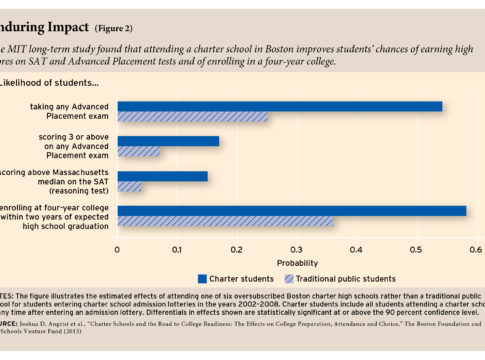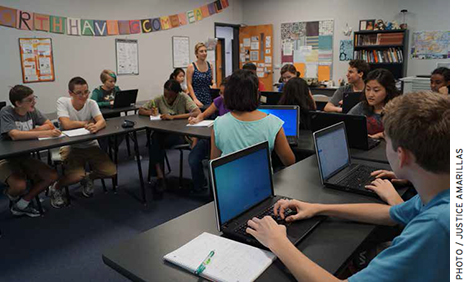 On the bottom shelf of a corner table in Barbara Dreyer’s office sits a glossy paperback book with “Math 2, A & B” on its cover.
On the bottom shelf of a corner table in Barbara Dreyer’s office sits a glossy paperback book with “Math 2, A & B” on its cover.
“We used to send out books that looked like this,” says Dreyer, as she holds the 500-page volume from one of the first-ever courses offered online by Connections Academy. “You could look at this information online, but, frankly, a lot of people were doing this,” she adds, thumbing through the book’s pages.
It’s been quite a journey from those early days of K–12 online learning, when students might still do much of their coursework by scribbling in those massive texts, to where the field is now. Dreyer, president and CEO at Connections Education, the nation’s second-largest for-profit online learning provider, has been at the helm of the Baltimore-based outfit for most of the way. Working alongside her have been Steven Guttentag and Mickey Revenaugh, now the respective president and executive vice president of the company’s Connections Learning division.
“Partly why we’re all still here is that we didn’t start out in the beginning and say we’re going to be here for 10 years,” says Dreyer, who came aboard in 2001, a year before Connections opened its first pair of virtual public schools in Colorado and Wisconsin. “I think what we said was, we’re going to be here as long as it’s interesting.”
Now, with online learning gaining more visibility, Dreyer and her colleagues may be embarking on their most important mission yet: to become an honest discussion leader about the strengths and weaknesses of online learning in the present, and the path of its future development.
“We need to talk about what’s not working; we can’t just say everything’s wonderful,” Dreyer says. “But it’s a little bit scary to talk about the fact that there are problems.”
Out in Front
The willingness to go into that uncomfortable territory has perhaps defined Dreyer and in turn Connections Education under her leadership.
Dreyer, whose mother taught in Baltimore’s industrial suburb of Dundalk, came to Connections from the technology start-up world of the 1990s, where she founded two separate companies. She also had professional connections to Sylvan Ventures, the investment group that funded the launch of Connections Education, and also gave rise to the Sylvan Learning tutoring and test preparation service.
And although Connections wasn’t the first organization to open virtual schools for K–12 students, like Dreyer the company has taken a different tack. Competitor K12 Inc., which launched in 1999, began by focusing mostly on providing services to already home-schooled students. Florida Virtual School (FLVS) initially only offered supplemental services to students who attended traditional brick-and-mortar high schools (see “Florida’s Online Option,” features, Summer 2009). Connections has targeted students currently enrolled in public schools, in the elementary and middle-school grades, yet who might for academic, behavioral, health, or other reasons desire an online alternative.
It was a risky strategy. Because most online learning of the era involved independent work and correspondence—think back to the “Math 2, A & B” manual—many believed younger students lacked the self-discipline needed to progress academically. To address that issue, Revenaugh created in Connections’ early education models the role of learning coach, usually parents or other relatives who would facilitate communications between teachers and students.
Further, Dreyer says she and Guttentag quickly identified the need to weave synchronous instruction—real-time communication between teachers and students—into all courses, long before it was a regular feature of online learning.
Similarly, the company took a bottom-up approach to constructing early versions of its education management system, or EMS. The initial version was hastily built and admittedly had limited functionality, Dreyer says, which turned out to be a blessing in disguise.
“We did not have many of the features that we have since found to be essential, such as a detailed student calendar, tools for reporting attendance, ways for teachers to ascertain student progress through a ‘dashboard,’ etc.,” Dreyer says. “However, we were quick to embrace any negative feedback and suggestions from our users. As a result, this limited first version actually turned out to be very beneficial.”
With its unique approach, Connections began to win respect and notoriety within the online learning community and the greater education world.
Educational accreditation, school improvement, and professional development company AdvancED certified Connections in the spring of 2005, just a year after the company topped 1,000 students in what were then six virtual public schools.
In 2008, Connections partnered with FLVS to help launch a full-time virtual program for Florida elementary- and middle-school students.
Crux Point
In terms of the emergence of Connections and K–12 online learning into the mainstream, however, none of those developments compares to Pearson’s purchase of the rapidly expanding company in September of 2011, for a reported $400 million.
The purchase, Dreyer says, developed from Connections’ history of utilizing Pearson-developed online course materials. Pearson, despite its reputation as one of the “Big Three” of the education-textbook publishing world, had shown a high level of sophistication in its digital offerings, she says. And as Connections had grown by then to more than 30,000 students across 22 virtual schools, expanding further was only possible under new ownership.
“Obviously, for Pearson to own a company in our space took a certain amount of bravery—to say, this is something that ultimately will benefit our school district customers,” notes Dreyer.
Dreyer says the arc of Connections’ growth, slow from 2001 to 2004 followed by accelerated expansion, followed a model perhaps more familiar in the start-up world than in education, in which the organization’s first schools were essentially testing grounds.
Connections compensated for unavoidable early missteps by heavily staffing their endeavors on the instruction side.
“With both Colorado and Wisconsin, we clearly made up for any shortfalls in the system by overemphasizing the role of the teacher,” says Dreyer.
That doesn’t mean, however, that the company had an abundance of employees when it convinced Sylvan Ventures and later the Apollo and Sterling investment groups to contribute resources for expansion.
“I believe that we were successful in making our case for support while we were scaling, and keeping our investors’ support for the team over time, because we were very careful to build our plans assuming that some things would go wrong and not overpromise,” she says. “This meant we were always running a leaner organization than we would have liked in order to control expenses.”
Connections’ ability to meet growth projections helped facilitate Pearson’s purchase, Dreyer says, as did its move earlier in 2011 to divide Connections Education into two departments: the familiar Connections Academy, which continued to run full-time virtual-school operations, and the new Connections Learning, built to offer blended-learning services to customer schools and districts.
Dreyer says the potential reach for blended learning, which combines instructional methods from online and face-to-face teaching, is much greater than fully virtual instruction. Currently, blended methods are used to help add personalized features to courses, expand offerings without having to expand teaching force size or class space, aid students with credit recovery, and serve students who might not be able to attend classes on campus five days a week.
“We said, ‘We have something for the 1 or 2 percent, let’s have something for the 98 percent,’” Dreyer explains.
The sale to Pearson allowed Connections to pursue its goals without making a public offering on the stock market, Dreyer says. By contrast, K12 Inc. went public in 2007. By early 2012, it was facing a lawsuit from shareholders claiming that the Herndon, Virginia–based company had exaggerated claims about its students’ academic success.
“We saw the challenges K12 faced as a public company and still faces as a public company,” Dreyer says. “That was not necessarily the most attractive option, or what we felt would help us move our mission forward.”
Critics Abound
While the suit against K12 Inc. reached a settlement in March 2013, the episode underscores the scrutiny that has come to the field. Since 2011 especially, online learning has been the subject of critical, and sometimes pointedly unfavorable, reports from national media outlets and education policy organizations.
The National Education Policy Center, or NEPC, an organization based at the University of Colorado in Boulder, has focused several of its recent publications on the practices of full-time virtual schools (see “Questioning the Quality of Virtual Schools,” check the facts, Spring 2013). A report published in October 2011 called for curbing the growth of full-time virtual schools until more was understood about how to make them more effective, and the following January the same group issued a report that suggested student achievement at virtual charter schools lagged behind brick-and-mortar charter schools.
Dreyer acknowledges that, like it or not, virtual schools’ exponential growth is a legitimate reason for increased oversight. The flow of students to online providers means more public dollars being directed to companies like Connections and K12 Inc. Connections’ continued expansion, to an estimated 50,000 students in 2013 (including those enrolled in blended programs served by Connections Learning), is more norm than exception. One-semester course completions at FLVS increased 30-fold during the last decade, numbering 300,000 in 2011–12.
To be fair, not all publicity has been negative. The bipartisan Digital Learning Now initiative, which has welcomed Dreyer to its advisory council, has pushed reforms aimed at increasing the online learning options available to students across the United States. And a series of working papers from the Thomas B. Fordham Institute published around the same time as the NEPC’s explorations of virtual schooling showed the practice in a more favorable light.
The Long View
While Dreyer admits the scrutiny has been deflating at times, she also says it shouldn’t be ignored. Some virtual programs don’t have the robustness of instruction or content and deserve to be questioned.
“We do think this emphasis on performance is really important,” Dreyer says. “What we don’t want to see happen is students’ choosing what’s easiest or what’s going to give them the best grade.… That’s a very short-term strategy and, frankly, it’s a strategy that we as a country maybe have had for too long. We’ve got to up our game, and we’ve got to up our game in online learning, too.”
Dreyer has launched a Connections initiative to redesign academic support systems for students who may be at risk given the point at which they enter an online program or their socioeconomic background, as she wrote in the spring 2013 issue of AdvancED’s quarterly newsletter on digital learning.
The brief argues that students often turn to online learning as a last resort. The achievement of virtual-school students should be measured against that of students from similar population groups, since a student’s income level, for example, can more closely correlate with student achievement than whether that student is studying traditionally or virtually.
And although Dreyer hopes the new support systems are effective, she says it’s more important that the initiative helps reshape public discussion, and helps unearth what exactly contributes to the quality of a given virtual school.
“This isn’t just about us,” Dreyer says. “This is about what is going to help the greatest number of kids and assuring that they have lots of choices. Families need to look at what’s right for them. And you have to accept that it might not be you.”
Ian Quillen is a Baltimore-based freelance journalist who has spent the last decade covering sports, education, and technology.
This article appeared in the Winter 2014 issue of Education Next. Suggested citation format:
Quillen, I. (2014). Making Connections: A conversation with Barbara Dreyer. Education Next, 14(1), 62-65.





